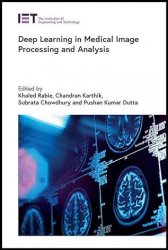Deep Learning in Medical Image Processing and Analysis
- Добавил: literator
- Дата: 16-10-2023, 03:15
- Комментариев: 0
 Название: Deep Learning in Medical Image Processing and Analysis
Название: Deep Learning in Medical Image Processing and AnalysisАвтор: Khaled Rabie, Chandran Karthik, Subrata Chowdhury, Pushan K. Dutta
Издательство: The Institution of Engineering and Technology
Год: 2023
Страниц: 376
Язык: английский
Формат: pdf (true)
Размер: 25.0 MB
This book introduces the fundamentals of Deep Learning for biomedical image analysis for applications including ophthalmology, cancer detection and heart disease. The book discusses multimedia data analysis algorithms and the principles of feature selection, optimisation and analysis.
In the whole world, people are suffering from a variety of diseases. In order to detect these diseases, several medical imaging procedures are used in which images from different parts of the body are captured through advanced sensors and well-designed machines. These medical imaging procedures increase the expectations of patients in achieving better healthcare services from medical experts. Till now, various image processing algorithms such as neural networks (NN), convolutional neural networks (CNN), and Deep Learning are used for image analysis, image representation, and image segmentation. Yet, these approaches are not giving promising results in some applications of the healthcare sector. So, this chapter gives an overview of state-of-the-art image processing algorithms as well as highlights its limitations. Most Deep Learning algorithm implementations focus on the images of digital histopathology, computerized tomography, mammography, and X-rays. This work offers a thorough analysis of the literature on the classification, detection, and segmentation of medical image data. This review aids the researchers in considering necessary adjustments to Deep Learning algorithm-based medical image analysis. Further, the applications of medical image processing using Artificial Intelligence (AI), Machine Learning (ML), and Deep Learning in the healthcare sector are discussed in this book.
Recently, Artificial Intelligence (AI) that is based on Deep Learning has gained a lot of attention. Deep learning is a new technique that has a wide range of potential uses in ophthalmology. To identify diabetic retinopathy (DR), macular edema, glaucoma, retinopathy of prematurity, and age-related macular degeneration (AMD or ARMD), DL has been utilized in optical coherence tomography, images of fundus, and visual fields in ophthalmology. DL in ocular imaging can be used along with telemedicine as an effective way to find, diagnose, and check up on serious eye problems in people who need primary care and live in residential institutions. However, there are also possible drawbacks to the use of DL in ophthalmology, such as technical and clinical difficulties, the inexplicability of algorithm outputs, medicolegal concerns, and doctor and patient resistance to the “black box” AI algorithms. In the future, DL could completely alter how ophthalmology is performed. This chapter gives a description of the cutting-edge DL systems outlined for ocular applications, possible difficulties in clinical implementation, and future directions. Artificial Intelligence (AI) is used in computer-aided diagnostics (CAD), which is one way to make the process of diagnosis more accurate and easier to use. “Deep Learning” (DL) is the best way to use AI for many tasks, including problems with medical imaging. It has been utilized for diagnostic imaging tasks for various diseases in ophthalmology.
Скачать Deep Learning in Medical Image Processing and Analysis
Внимание
Уважаемый посетитель, Вы зашли на сайт как незарегистрированный пользователь.
Мы рекомендуем Вам зарегистрироваться либо войти на сайт под своим именем.
Уважаемый посетитель, Вы зашли на сайт как незарегистрированный пользователь.
Мы рекомендуем Вам зарегистрироваться либо войти на сайт под своим именем.
Информация
Посетители, находящиеся в группе Гости, не могут оставлять комментарии к данной публикации.
Посетители, находящиеся в группе Гости, не могут оставлять комментарии к данной публикации.
